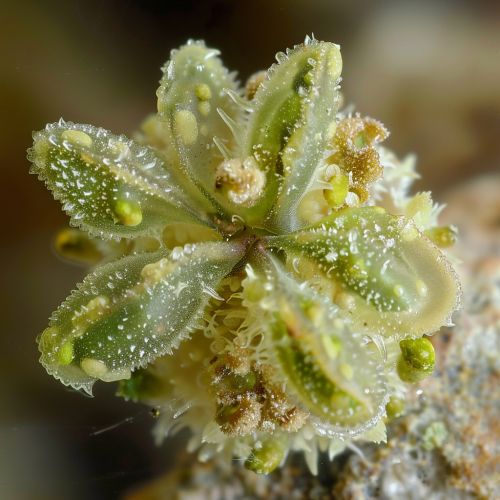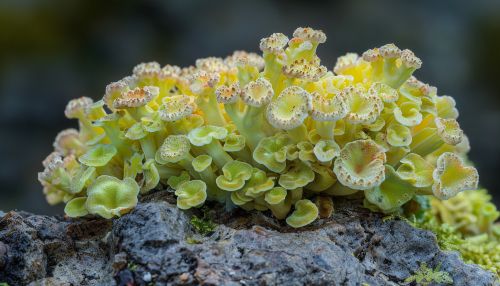Thallus
Introduction
A thallus (plural: thalli) is a plant body that is not differentiated into stems and leaves and lacks true roots and a vascular system. Thalli are typical of algae, fungi, and lichens. The term "thallus" is derived from the Greek word "thallos", which means a green shoot or twig. The concept of a thallus is part of the structural classification of plants, which is distinct from their reproductive, evolutionary, or genetic classifications.
Structure and Function
The structure of a thallus can range from simple to complex. In algae, the thallus may be unicellular or multicellular. In fungi and lichens, the thallus is typically multicellular. The cells of a thallus often contain chlorophyll, the pigment responsible for photosynthesis. However, in fungi and some algae, the cells may lack chlorophyll and instead obtain nutrients through absorption or symbiosis with other organisms.


A thallus performs all the basic functions of a plant, including photosynthesis, nutrient absorption, and reproduction. In algae and lichens, the thallus is often the main photosynthetic part of the organism. In fungi, the thallus (also known as the mycelium) is primarily involved in nutrient absorption.
Types of Thallus
There are several types of thallus, including filamentous, parenchymatous, and pseudoparenchymatous.
Filamentous Thallus
A filamentous thallus consists of long, thin cells arranged end-to-end, forming a filament. This type of thallus is common in many algae, such as Spirogyra and Cladophora, and in some fungi.
Parenchymatous Thallus
A parenchymatous thallus consists of cells that are similar in shape and size, forming a tissue-like structure. This type of thallus is common in some algae, such as Ulva and Fucus, and in some lichens.
Pseudoparenchymatous Thallus
A pseudoparenchymatous thallus appears similar to a parenchymatous thallus but is formed from filaments that are closely packed together. This type of thallus is common in some fungi, such as Aspergillus and Penicillium.
Thallus in Algae
In algae, the thallus can be unicellular, colonial, filamentous, or parenchymatous. The simplest algae, such as Chlamydomonas, have a unicellular thallus. Colonial algae, such as Volvox, have a multicellular thallus that is formed from a colony of individual cells. Filamentous algae, such as Spirogyra, have a thallus that is formed from a long chain of cells. Parenchymatous algae, such as Ulva, have a thallus that is formed from a sheet of cells.
Thallus in Fungi
In fungi, the thallus (also known as the mycelium) is typically a network of filaments called hyphae. The hyphae are usually branched and can penetrate the substrate, absorbing nutrients. Some fungi, such as yeasts, have a unicellular thallus.
Thallus in Lichens
In lichens, the thallus is typically a layered structure. The layers include a layer of fungal hyphae, a layer of algal or cyanobacterial cells, and another layer of fungal hyphae. The thallus of lichens can have various forms, including crustose (crust-like), foliose (leaf-like), and fruticose (branch-like).
